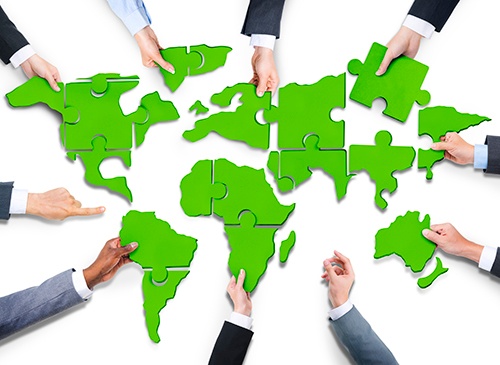
At the Millennium Summit in September 2000, a large gathering of world leaders adopted the UN Millennium Declaration, committing their nations to a new global partnership to reduce extreme poverty. The summit established eight targets that have become known as the Millennium Development Goals. (Editor’s note: For more on the Millennium Development Goals, visit www.unmillenniumproject.org.)
The MDGs are quantified targets for addressing extreme poverty such as income poverty, hunger, disease, lack of adequate shelter, and exclusion. The MDGs also promote gender equality, education, and environmental sustainability. They are designed to encompass the basic human rights of each person on the planet to health, education, shelter, and security. The MDGs include:
- Eradicate Extreme Hunger and Poverty
- Achieve Universal Primary Education
- Promote Gender Equality and Empower Women
- Reduce Child Mortality
- Improve Maternal Health
- Combat HIV/AIDS, Malaria, and Other Diseases
- Ensure Environmental Sustainability
- Develop a Global Partnership for Development
The Millennium Project leaders say the world has made significant progress in achieving many of the goals. For example, between 1990 and 2002:
- Average overall incomes increased by approximately 21 percent.
- The number of people in extreme poverty declined by an estimated 130 million.
- Child mortality rates fell from 103 deaths per 1,000 live births a year to 88.
- Average life expectancy rose from 63 years to nearly 65 years.
- An additional 8 percent of the developing world's people received access to water, and an additional 15 percent acquired access to improved sanitation services.
However, progress has been far from uniform across the world, and not surprisingly, there are huge disparities within countries.
Sustainable Development Goals
On September 25, 2015, the United Nations General Assembly adopted 17 Global Goals for Sustainable Development — also called the Global Goals or Sustainable Development Goals (SDGS) — to end poverty, protect the planet, and ensure prosperity for all as part of a new sustainable development agenda. Each goal has specific targets to be achieved over the next 15 years.
The SDGs build on the MDGs. However, the SDGs and the broader sustainability agenda go much further than the MDGs, addressing the root causes of poverty.
The 2030 Agenda is a plan of action that seeks to strengthen universal peace. It recognizes that eradicating poverty in all its forms is the greatest global challenge and an indispensable requirement for sustainable development. The idea is that all countries and stakeholders will partner to implement this plan. The goal:
“We are resolved to free the human race from the tyranny of poverty and want and to heal and secure our planet. We are determined to take the bold and transformative steps which are urgently needed to shift the world onto a sustainable and resilient path. As we embark on this collective journey, we pledge that no one will be left behind.
“The 17 Sustainable Development Goals (SDGs) and 169 targets which were announced are integrated and indivisible and balance the three dimensions of sustainable development: economic, social, and environmental. The goals and targets will stimulate action over the next 15 years in areas of critical importance for humanity and the planet.”
"This agreement marks an important milestone in putting our world on an inclusive and sustainable course,” says United Nations Development Programme (UNDP) Administrator Helen Clark. “If we all work together, we have a chance of meeting citizens’ aspirations for peace, prosperity, and wellbeing, and to preserve our planet."
Here are the five categories of SDGs:
- People: End poverty and hunger and ensure that all human beings can fulfil their potential in dignity and equality and in a healthy environment.
- Planet: Protect the planet from degradation, including through sustainable consumption and production, sustainably managing its natural resources, and taking urgent action on climate change so that it can support the needs of present and future generations.
- Prosperity: Ensure that all human beings can enjoy prosperous and fulfilling lives and that economic, social, and technological progress occurs in harmony with nature.
- Peace: Foster peaceful, just, and inclusive societies that are free from fear and violence. There can be no sustainable development without peace and no peace without sustainable development.
- Partnership: Mobilize the means required to implement this agenda through a revitalized Global Partnership for Sustainable Development, based on a spirit of strengthened global solidarity, focused in particular on the needs of the poorest and most vulnerable and with the participation of all countries, all stakeholders, and all people.
Within the five categories, there are 17 goals. Seven are particularly relevant to the automotive industry:
|
Goal 6 |
Ensure availability and sustainable management of water and sanitation for all |
|
Goal 7 |
Ensure access to affordable, reliable, sustainable and modern energy for all |
|
Goal 8 |
Promote sustained, inclusive and sustainable economic growth, full and productive employment and decent work for all |
|
Goal 9 |
Build resilient infrastructure, promote inclusive and sustainable industrialization and foster innovation |
|
Goal 12 |
Ensure sustainable consumption and production patterns |
|
Goal 13 |
Take urgent action to combat climate change and its impacts. |
|
Goal 17 |
Strengthen the means of implementation and revitalize the global partnership for sustainable development |
To get involved in AIAG’s Environmental Sustainability Work Group and other corporate responsibility initiatives, email CR@aiag.org.
Resources
Read the full resolution of the General Assembly.
Access the Sustainable Development Knowledge Platform.
See “The World We Want: A Young Person’s Guide to the Global Goals for Sustainable Development,” developed by the Latin America and Caribbean Movement for Children, 2015.


